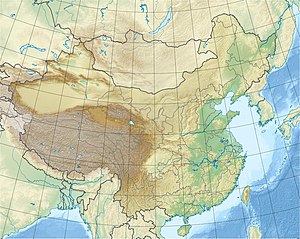Xiaolangdi Dam
| Xiaolangdi Dam | |||||||
|---|---|---|---|---|---|---|---|
|
|||||||
|
|
|||||||
| Coordinates | 34 ° 55 '26 " N , 112 ° 21' 55" E | ||||||
| Data on the structure | |||||||
| Construction time: | 1994-2005 (approx.) | ||||||
| Height of the structure crown: | 160 m | ||||||
| Building volume: | 50.73 million m³ | ||||||
| Crown length: | 1667 m | ||||||
| Power plant output: | 1800 MW | ||||||
| Data on the reservoir | |||||||
| Altitude (at congestion destination ) | 275 m | ||||||
| Storage space | 12.65 billion m³ | ||||||
| Design flood : | 52,300 m³ / s | ||||||
The Xiaolangdi Dam is a large dam on the Yellow River ( Huang He ) in China. It is located in the Mengjin and Jiyuan area , 40 km north of Luoyang in Henan Province . The dam serves several purposes. The associated hydropower plant has an output of 1800 MW . The dam is also used for irrigation, water supply, flood protection and the control of sediments .
dam
The dam is about 130 km below the Sanmenxia Dam and 128 km above the Huayuankou Dam. It consists of rock fill and has been built to be earthquake-proof . The overflow has a device to prevent the overflows from becoming clogged with ice floes. Construction began in 1994 and will last for 11 years. In January 2004 the first power plant turbine was put into operation. The total construction costs are estimated at 4.2 billion US dollars.
The dam is 160 m high and 1667 m long. The volume of the structure is 50.73 million m³.
power plant
In the underground power plant (length × width × height 251 × 26 × 61 m) 6 machines with a capacity of 300 MW each are installed, so that the power plant has an installed capacity of 1800 MW. The annual production is 5.1 billion kWh .
irrigation
Two million hectares of land are irrigated by the dam. There are nine large tunnels to extract and discharge water. The Yellow River loses a lot of water by irrigating large areas, so that it sometimes dries up in dry periods. In the last few decades it has had so little water several times that it no longer reached the sea at times, as happened in 1972 and 1997.
Flood protection
The country has often been hit by floods, but also by drought and starvation. The dam is supposed to withstand a 10,000-year flood and mitigate it, for example the runoff is to be reduced from 45,000 m³ / s to 27,500 m³ / s. Below the dam, large areas previously at risk of flooding are now available for agriculture. With the construction of the dam, the likelihood that the two large flood polders, Dong Ping Hu and Beijindi, will have to be flooded will decrease. For Dong Ping Hu the probability is now once in 100 years, for Beijindi once in 1000 years. The project will protect 103 million people in northern China, several large cities and industry from floods.
Sediments
The sludge of the Yellow River is deposited in the lower reaches and causes a constant rise of the river bed, so that the dikes have to get higher and higher. Every year they have to be increased by 10 cm, which causes enormous costs and cannot go on permanently because the dikes are becoming unsafe. The dam should be able to hold sediments for 20 years.
Resettlement
The project was partially funded by the World Bank . The environmental impact has been studied, among other things, to meet World Bank requirements. Plans have been put in place to protect historic sites and public health and welfare. Approximately 181,000 people had to be relocated, mostly rural people. You will receive compensation and new residential areas with at least as good houses and earning potential as before.
Alternatives
The following alternatives to building the dam have been considered:
- Raising the dykes for a 1000-year flood would have been very costly and would not have prevented sediment from being deposited in the lower reaches.
- Measures to prevent the erosion of the loess soil in the catchment area would be better in the long term, but would not have improved flood protection. Irrigation and power generation would not have been made possible.
- An additional flood relief channel next to the river would have resulted in great costs, disrupted communications and transport links and irrigation, and 700,000 to 930,000 people would have to be relocated.
- 500,000 people would have had to be relocated to expand or build the existing canals.
See also
- List of hydropower plants in China
- List of dams in China
- List of the largest dams on earth
- List of the largest reservoirs on earth
- List of the largest hydroelectric plants in the world
Web links
- China Internet Information Center: The Xiaolangdi Water Control Project
- Experience with Dams in Water and Energy Resource Development in the People's Republic of China (p. 5) (PDF file; 1.85 MB)
- Japan Dam Foundation ( Memento from January 31, 2009 in the Internet Archive )
- Dam committee: see there p. 5 (PDF file; 1.85 MB)
